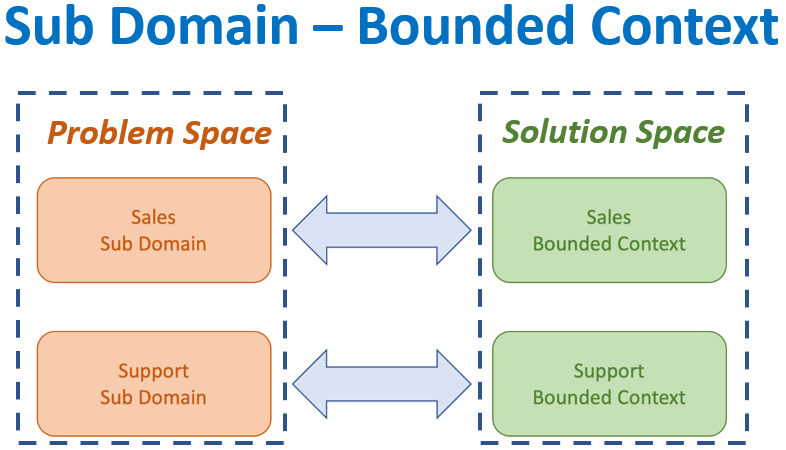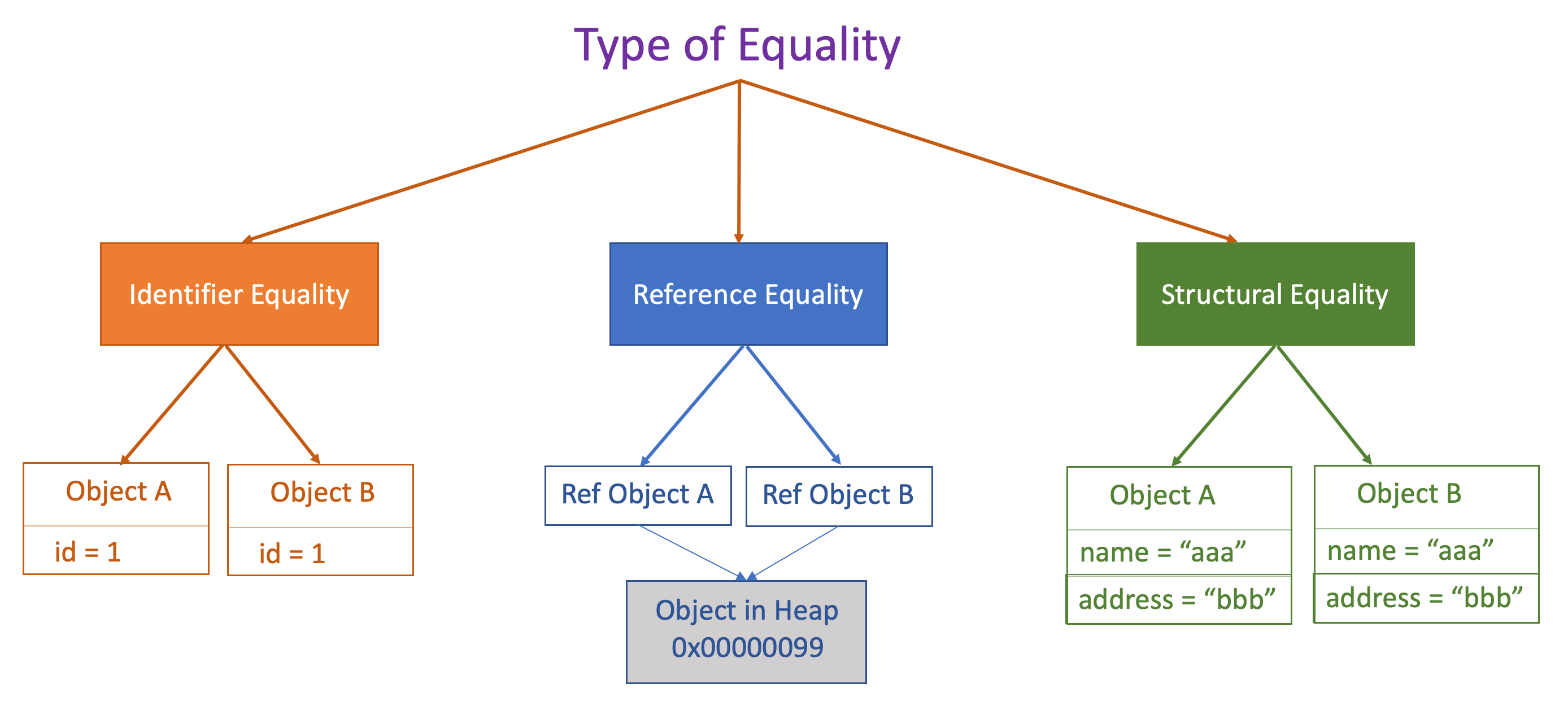I believe there are tons of articles and books out there that discuss about Domain Driven Design (DDD for short). This post essentially is taken from my note archieved when I explored about DDD from several resources. I rewrite it in here as a refresh for myself mainly.
Domain Driven Design (DDD) is the concept that the structure and language of software code (class names, class methods, class variables) should match the business domain [1]. We don’t need to kill a mosquito with a cannon. We need to choose the fittest method in solving a problem. As well as DDD, it is not always be a fit method in solving application design. A software application has several attributes. Some of them deal with:
- Amount of Data
- Performance
- Business Logic complexity
- Tehnical Complexity.
From the fourth software attributes, DDD is the most suitable with an application that has a complex business logic. DDD is designed to tackle the complexity of business rules. The main goals of DDD are[1]:
- Placing the project’s primary focus on the core domain and domain logic;
- Basing complex designs on a model of the domain;
- Initiating a creative collaboration between technical and domain experts to iteratively refine a conceptual model that addresses particular domain problems.
One of good resources about DDD is DDD course by Vladimir Khorikov. I also cited a few/snippet code from his course to make my summary about DDD more clearer to understand.
Terms in DDD
Ubiquitous Languange
Ubiquitous Languanges bridges the gab between developer and business expert/ domain expert/ subject matter expert (SME). The Ubiquitous Languange notion come up to avoid misunderstanding between them. For example, the developer has a class Product that represent business term Product (both product and package). On the other hand the business expert treat Product and Package as different things. By the condition, it is needed the same languange to avoid misunderstanding.
Bounded Context
Bounded Context is a central pattern in DDD. It is the focus of DDD’s strategic design section which is all about dealing with large models and teams. DDD deals with large models by dividing them into different Bounded Contexts and being explicit about their interrelationships [Martin Fowler - BoundedContext].
Bounded Context notion comes up to make clear boundries between different parts of the system. Let’s say our system consist of Sales and Support, we can seperate Product into Sales and Support context to make clear boundries between the two.

Source: https://martinfowler.com/bliki/BoundedContext.html
Figure 1 shows that Bounded Context aims for separating the model and explicitly drawn the boundaries between pieces. The reason for context separation is that as the application grows, it becomes harder to maintain a single unified model as it becomes larger and more people get involved in the development process.
Sub Domain
The difference between Sub Domain and Bounded Context is that the Sub Domain is a Problem Space. Meanwhile Bounded Context is a Solution Space. Sub Domain and Bounded Context have a 1-to-1 relation. It means that a Sub Domain should be covered with exactly a Bounded Context.

Since Sub Domain is a Problem Space, it should be defined by Business Expert or Domain Experts. The Sub Domain topic usually will come up when we have a talk with the Domain Expert while gathering requirement.
Core Domain
The notion that focuses on Domain Model which is the most important part of the system.
Onion Architecture
The implementation of DDD in onion architecture showed in the Figure 3.

Figure 3 shows that the core of the architecture is the Domain Model. The Domain Model is isolated from others for seperation of consern purpose. It consists of Entities, Value Objects, Domain Events, and Agregates. They are most important part in DDD since they represent business logic implementation.
The outer layer in the onion architecture depends on the inner one. The inner layer is isolated from the outer layer that make the inner layer does not know the outer one. Figure 3 denotes that the Domain Model does not know how it is peristed to database. Since persisting model to database is handled by Repository on the outer layer.
Testing in TDD
Unit Test is one of important part in software development. Test coverage that reaches 100% has high effort. In practice the most important that should cover most unit test is the code base (Domain Model) at the inner most layer in the onion architecture. The closer to 100%, the better the Unit Test coverage will be. Meanwhile for the outer layer, the test schenario could be coveraged by integration test.
Entity vs Value Object
The difference between Entity and Value Object can be identified from several ways:
- Type of Equality
- Immutability
- Lifespan
1. Type of equality
Type Equality is applied to the objects which have the same type. It is classified into 3 categories:
-
Identifier Equality
Two objects A and B are identified have Identifier Equality if they have the same Id. -
Reference Equality
Two objects A and B are identified have Reference Equality if they point to the same memory address. -
Structural Equality
Two objects A and B are identified have Structural Equality if all the member values are matched.
The 3 types of Type Equality is summarized in the following Figure.

Identifier Equality usually referes to Entity. Meanwhile Structural Equality refers to Value Object. The Reference Equality can be applied to Entity or Value Object. In practice, Value Object does not has an Id.
2. Immutability
The characteristic of Entity:
- Having identity Id
- Mutable
The characteristic of Value Object:
- Having no identity Id
- Immutable
3. Lifespan
From the lifespan point of view, Value Object can not live by its own. It can be owned by one or several identities.
For example Address object can not stay by its own. It should be belonged to Person object. From persistance perspective, Value Object does not have its own table in database.
How to Recognize Entity or Value Object
It is not always clear having specific characteristic if a term or notion in a business process is an Entity or Value Object. It depends on the business process itself. A good approach to identify whether a notion of object is an Entity or Value Object is by comparing to integer.
//Integer
public void MethodA(){
int value1 = 5;
int value2 = 5;
}
//Value Object
public void MethodB(){
//money1 and money2 essentially the same.
//since they have the same nominal in business process context.
//programmatically they both have the same structure equality
Money money1 = new Money(5);
Money money2 = new Money(5);
}
Ideally most business logic elements are identified as Value Objects. The Entity act as a wrapper of Value Object(s). However, don’t hesitate to refactor Value Object to Entity or vise versa if we identify it should be.
public abstract class Entity
{
public virtual long Id { get; protected set; }
public override bool Equals(object obj)
{
var other = obj as Entity;
if (ReferenceEquals(other, null))
return false;
if (ReferenceEquals(this, other))
return true;
if (GetRealType() != other.GetRealType())
return false;
if (Id == 0 || other.Id == 0)
return false;
return Id == other.Id;
}
public static bool operator ==(Entity a, Entity b)
{
if (ReferenceEquals(a, null) && ReferenceEquals(b, null))
return true;
if (ReferenceEquals(a, null) || ReferenceEquals(b, null))
return false;
return a.Equals(b);
}
public static bool operator !=(Entity a, Entity b)
{
return !(a == b);
}
public override int GetHashCode()
{
return (GetRealType().ToString() + Id).GetHashCode();
}
private Type GetRealType()
{
return NHibernateProxyHelper.GetClassWithoutInitializingProxy(this);
}
}
public abstract class ValueObject<T>
where T : ValueObject<T>
{
public override bool Equals(object obj)
{
var valueObject = obj as T;
if (ReferenceEquals(valueObject, null))
return false;
return EqualsCore(valueObject);
}
public override int GetHashCode()
{
return GetHashCodeCore();
}
public static bool operator ==(ValueObject<T> a, ValueObject<T> b)
{
if (ReferenceEquals(a, null) && ReferenceEquals(b, null))
return true;
if (ReferenceEquals(a, null) || ReferenceEquals(b, null))
return false;
return a.Equals(b);
}
public static bool operator !=(ValueObject<T> a, ValueObject<T> b)
{
return !(a == b);
}
protected abstract bool EqualsCore(T other);
protected abstract int GetHashCodeCore();
}
Agregate
Aggregate is a pattern in DDD. It is a cluster of domain objects that can be treated as a single unit for data changes. It also frequently known as a business model. Aggregate encapsulates Entities and/or Value Objects (domain objects). An Entity can belong to a single Agregate only. Meanwhile a Value Object can belong to multiple Agregates.
An Agregate contains a set of operations which those domain objects can be operated on. An Agregate also act as a single operation unit. Application layer should reload it from database, then perform action and store it back as a single object. Hence, the Agregate should not be too large. Commonly it contains maximum 3 Entities. On the contrary to Entity, we can have as many Value Objects in an Agregate as we want.

An Aggregate Root is a single, specific Entity contained in the aggregate.
public abstract class AggregateRoot : Entity
{
}
public abstract class Repository<T> where T : AggregateRoot
{
public T GetById(long id)
{
throw new NotImplementedException("load data from database");
}
public void Save(T aggregateRoot)
{
throw new NotImplementedException("operation insert to database");
}
}
Domain Event
Domain Event represents an event that’s significant to the Domain Model. It’s important to distinguish Domain Event to System Event. System Event deals with infrastructure event such as button click, timer tick, window close etc. On the other hand, Domain Event describe occasion which is important to the Domain. For example, when a button clicked (System Event), it calls a domain operation. Domain operation trigger an event to change balance values in other Bounded Context for example head office.
Domain Event is often used to[3]:
- Decouple Bounded Context
- Facilitate communication between Bounded Context
- Decouple Entities within a Bounded Context
The guidelines in implementing Domain Event are[3]:
- Naming should be in Past Tense. Example:
BalanceChangedEvent - Passing data as small/little as possible. Don’t pass data/information more than needed.
- We should not pass Entity to an Event. Since it will produce additonal point of coupling. We should use primitive data type instead.
